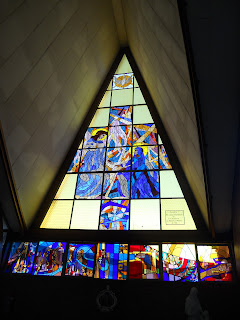 |
| The Coke Machine at the Ferry Terminal to go to Robben Island |
My last trip to Cape Town, we had tried to go out to Robben Island, but the transit workers were on strike and we never made it. Friends had told me what a powerful experience it was and while I believed them I was not fully prepared for the experience.
The day started as a cloudless day with no wind and very smooth seas. As I stood on the stern of the boat, watching Cape Town get further and further away, on the top deck a group of South Africans were chanting, singing and dancing and the dolphins were playing out in our boat wake. At this moment, I was overcome with the significance of what I was about to experience in this sacred place.
 |
| Dancing and Signing on the Top Deck |
We arrived on the Island and were shuttled onto buses for the initial part of the tour.
Our guide, Kent, explained that the island has been housing prisoners since the end of the 17th century. There are people buried all over the island. Ever time they excavate a new place they find human remains. The only existing cemetery on the island currently is the Leper Cemetery.
 |
| The leper cemetery |
From here we continued on to the dog kennels and the place where Robert Sobukwe was held in solitary confinement. He had formed the Pan Africanist Congress and was charged with incitement when he encouraged opposition to the Dom Pas Law. On the day he turned himself in at the Orlando Police Station in Soweto, 69 people were killed and over 180 injured in Sharpsburg while showing their opposition to the law, most were said to have been shot in the back by the police.
 |
| Dog kennels behind Robert Sobukwe's Solitary Cell |
We continue on to the limestone quarry where prisoners from Cell Block B had worked.
 |
| Limestone Quarry |
We then saw the two churches on the island. The first was the church from the leper colony. Ever other building from that time had been torn down, but this remains as it was built with private funds and could not be torn down. The second church was the one for the small town, where the guards lived with their families.
 |
| People's Church |
Finally we arrived at the maximum security prison where political prisoners were kept during the Era of Apartheid. Our guide for this part of the tour was a former political prisoner. He lived in Block A, cell 13. He told us of the terrible things that happened to him as a political prisoner and also of the things he learned while in prison. From his experiences, Nelson Mandela was an amazing leader even while imprisoned on Robben Island. When the prisoners didn't want to learn Afrikaans and live by the guard's rules - he told them the best way to know your enemy is to know their language. And they learned Afrikaans. When the guards beat them, he told them to be peaceful and respectful. And some of the guards grew sympathetic to the prisoners, smuggling in letters and even chocolate birthday cake.
 |
| Our Guide for the prison tour |
 |
| Outside of the maxium security prison |
 |
| An empty cell 2.5m x 2.5 m |
 |
| Nelson Mandela's Cell |
 |
When he was told nothing would grow in the garden, Mandela planted peppers
and other things including the grapes that still grow there today. |
Overall an amazing journey. As our tour guide said "Thank you to the world for helping South Africa end Apartheid. It would not have happened without pressure from citizens and governments all around the world"
















































